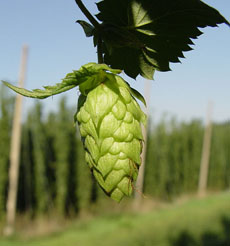FOOD 101: What Are Hops?
|
September 28th is Drink Beer Day. Only a few ingredients are needed to make beer; typically, barley malt, unmalted grain, hops, yeast and water. We were explaining to a friend that our favorite beers are heavily hopped IPAs. “What exactly are hops?” he asked. We turned to Samuel Adams, the pioneering craft beer brewer, and to USA Hops, a nonprofit organization of growers, for an education. A hop is a flower that looks like a soft, green pine cone. It grows on a long vine. The flowers are almost exclusively used as a brewing spice in the production of beer. But what’s important to the brewer is not the whole flower or the petals, but the lupulin glands inside, which contain a golden resin. This resin is the depository of the alpha acids necessary for the hops to impart their signature bitterness and flavor to the beer. It also acts as a natural preservative. |
 Hops on the vine. Photo courtesy Wikimedia. |
|
|
In mass brews, hops lend bitterness and not a lot more. But craft brewers select very specific types of premium hops, for their special aromatic flavor qualities over their bittering value. Aroma hops, as they are known, have lower alpha acid levels and produce an array of complex flavors and aromas—from citrus and fruit to pine and eucalyptus. Like any agricultural product, the unique conditions of soil, moisture, elevation and sunlight of the particular field have a direct impact on the quality and character of the hops. Hop varieties grown in their original regions will impart different flavors when grown elsewhere. The “hop belt,” where the most flavorful hops thrive, falls along the 48th parallel. Each region’s hop varieties impart different flavors, from the aromatic piney notes in German hops to earthy ale hops in England and the citrus brightness of American hops. SOME HOPS HISTORY The oldest hop growing region in the world is located in Bavaria, a temperate region in southeast Germany, just west of the Alps (Munich is the capital). The local Noble aroma hops varieties, low in bitterness and high in aroma, are prized worldwide. The earliest beers weren’t made with hops. The earliest mention of hop growing dates only to 1000-1200 C.E. in Germany. Prior to hops, other bittering agents, from juniper to roots and pine, were used. None could create the layers of flavor that hops impart, and it was a lucky day when the first brewer tossed those green flowers into the brewing vat. |
||


